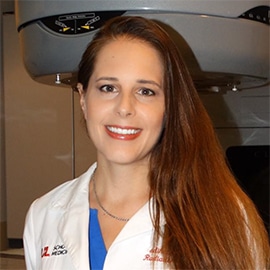
Radiation therapy is an essential treatment after surgery for many women with ductal carcinoma in situ (DCIS) and stage I, II, and III breast cancer. When radiation treatments are given to the breast tissue after a lumpectomy, the radiation treatment has been shown to decrease the risk of tumor regrowth in the breast and surrounding tissues by 50-60 percent. Additionally, radiation therapy has been shown to lengthen survival times and increase cure rates in the general population of women with early stage, invasive breast cancer.
During radiation therapy planning for breast cancer, it is standard for the radiation oncology physician to monitor how much heart tissue will be exposed to the radiation beams during the patient’s treatment. This is especially important for women with cancer in their left breast because the heart sits behind the left breast and rib cage. If the heart tissue is exposed to high doses of radiation or if large volumes of the heart are within the path of the radiation beam, it could increase the patient’s risk of heart disease in the years after her breast cancer treatment.
Fortunately, modern radiation treatments are very effective in limiting the amount of radiation dose that the heart tissue receives and, as a result, heart disease due to radiation therapy is uncommon. To ensure the safest and effective treatment for breast cancer, radiation doctors at UofL Hospital and UofL Health – Brown Cancer Center offer a variety of specialized, heart-sparing radiation techniques.
Breath Hold
Sometimes called Deep Inspiration Breath Hold or Active Breathing Control, repetitive breath hold maneuvers are a surprisingly simple way to limit cardiac exposure to radiation. During radiation treatment, women are instructed to take a deep breath and hold it for approximately 10 seconds. The deep breath inflates the patient’s lungs, expands the chest and moves the breast tissue further away from the heart. This technique typically reduces the radiation dose to the heart by 60 percent or more.
Prone Positioning
During treatment with the prone technique, women lie face down and on their stomachs on a special radiation treatment table. It’s similar to a massage table in the sense that there is a special opening in the table – designed for the breast that is to be treated with radiation. Gravity causes the breast tissue to fall away from the rib cage and underlying heart muscle, which moves the heart further away from the path of the radiation beam.
Partial Breast Irradiation
Some women with early-stage breast cancer can have their breast cancer adequately treated by giving radiation therapy to only a portion of the breast tissue, as opposed to giving radiation to the whole breast. Two common techniques for partial breast irradiation are:
- Accelerated partial breast irradiation (gives a higher dose over a shorter time than is given in standard whole-breast radiation therapy)
- Intraoperative radiation therapy (IORT – a single dose of radiation therapy given during a lumpectomy).
Depending on the location of the breast tumor in the breast, the partial breast irradiation technique may also decrease the amount of radiation dose that the heart receives by providing more focused radiation therapy.
Intensity Modulated Radiation Therapy and Three-Dimensional Conformal Radiation Therapy
These two techniques refer to the practice of conforming or shaping the distribution of radiation dose in the body to the shape of the radiation target—in this case, the breast tissue. These techniques allow the radiation therapy team to control where the radiation dose travels in your body and how much of a dose will be deposited in those tissues. These techniques allow radiation treatments to be customized to a patient’s anatomy and are highly effective in limiting the amount of radiation dose that the heart receives during breast cancer treatment.
If you’ve been diagnosed with breast cancer and want to learn more about how heart-sparing radiation techniques may benefit you, call UofL Health – Brown Cancer Center Department of Radiation Oncology at 502-562-4360.
The Brown Cancer Center also offers a Cardio-Oncology for patients going through cancer treatment and are at risk of cardiac complications or already have risk factors for heart disease. Learn more by visiting UofLHealth.org or call 502-588-4600.









